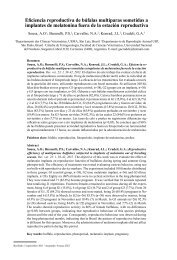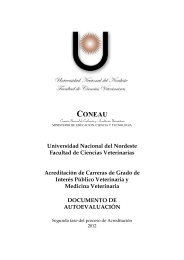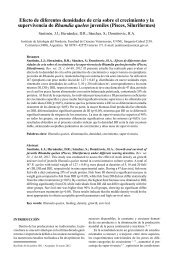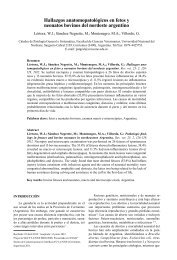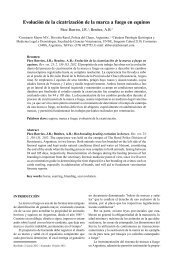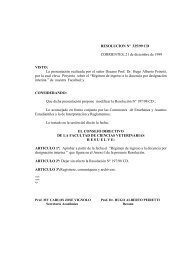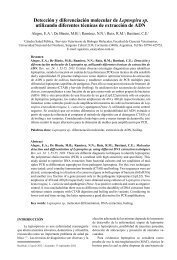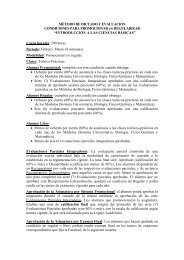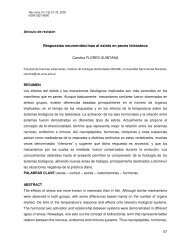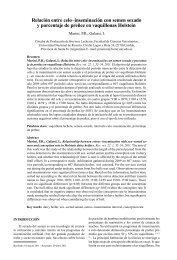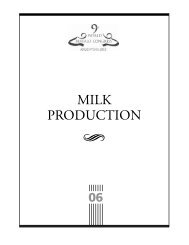REPRODUCTION - Facultad de Ciencias Veterinarias
REPRODUCTION - Facultad de Ciencias Veterinarias
REPRODUCTION - Facultad de Ciencias Veterinarias
Create successful ePaper yourself
Turn your PDF publications into a flip-book with our unique Google optimized e-Paper software.
834<br />
<strong>REPRODUCTION</strong><br />
In the last many years, the farmers experimented several natural remedies in animal reproduction and <strong>de</strong>veloped an<br />
intrinsic and invaluable knowledge from generation to generation. These invaluable practices have been passed from one<br />
generation to another by word to mouth. Various ethno-veterinary practices have also been used in the field for the<br />
treatment of anoestrus in Nili-Ravi buffalo but the effectiveness of these treatments have never been verified scientifically.<br />
There is an urgent need to evaluate the efficacy of these ethno-veterinary treatments. The main objective of this<br />
investigation was, therefore, to <strong>de</strong>termine the effectiveness of various ethno-veterinary practices for the treatments of<br />
anoestrus in Nili-Ravi buffalo and to compare them with hormonal treatment.<br />
MATERIALS AND METHODS<br />
The present study was accomplished on 60 Nili-Ravi buffalo with the history of true anoestrus and maintained at Buffalo<br />
Research Institute, Pattoki, District Kasur. To confirm no corpus leutum on ovaries, these buffaloes were examined two<br />
times through rectal palpation at 11 days interval. These animals were divi<strong>de</strong>d into four groups (A, B, C, D) comprising<br />
of 15 animals in each group. Group A was given orally 800 grams lens esculents moench daily for three days where as group<br />
B was given orally about 15 grams of randia dumetorum daily for four days. Group C was given a single intra-muscular<br />
injection of GnRH at the dose rate of 100 µg where as group D was given no treatment and served as control. All buffaloes<br />
were kept un<strong>de</strong>r similar managemental conditions. Detection of estrus was started after the treatments in each group. All<br />
buffalo were observed for estrus twice daily (0700 and 1800) for approximately 1 h during the experiment. A buffalo was<br />
recor<strong>de</strong>d to have shown estrus if she stood to be mounted by a herd mate.<br />
The blood samples from each buffalo were collected before the start of treatments and after the treatments, samples were<br />
taken after every three days interval from all experimental buffalo for progesterone (P 4 ) estimation.<br />
About 20 ml of blood from each animal was collected in a clean sterilized glass test tube through venipuncture of jugular<br />
vein using a sterile 16 gauge needle. The test tubes containing blood were placed in slanting position for one hour to<br />
let the serum ooze out and was aspirated carefully placed in glass vials, labeled and stored at -20 o C till analysed.<br />
Progesterone was analyzed through ELISA. The data thus collected was analyzed statistically.<br />
Table 1: Mean (±SD) values of progesterone (ng/ml) in anoestrus<br />
Nili-Ravi buffaloes before and after the different treatments.<br />
Values sharing different superscripts in a row differed significantly (P



